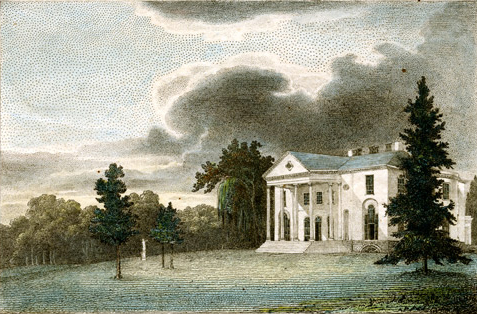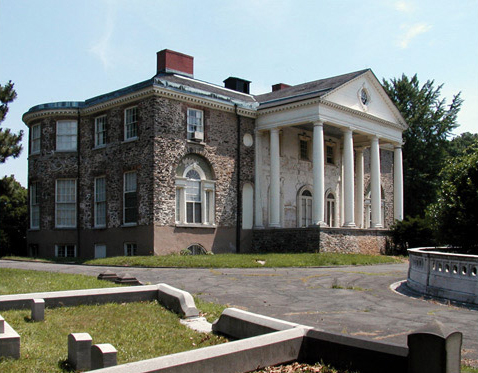Reprinted with the kind permission of The Woodlands Trust for Historic Preservation with additions by Joseph Mussulman.
Inception
The Woodlands in 1808
William Birch
Print and Picture Collection, (Castner 27:47). The Free Library of Philadelphia.
This hand-tinted engraving by William Birch is from his book, The Country Seats of the United States of North America, with some Scenes Connected with Them (Springland, Pennsylvania: 1808). In the 18th century, “seat” was a synonym for residence or mansion. At one time, Hamilton conceived The Woodlands as the centerpiece of an adjacent Hamiltonville, which was to have been an exclusive community of suburbanites’ country homes, but that development did not come about until the 1840s.
The Woodlands, once a 600 acre estate, is now reduced to a 45-acre site that has seen a remarkable succession of historical landscapes over three centuries. Deep within the grounds stands the imposing mansion rebuilt in the 1780s by William Hamilton, long recognized for its architectural preeminence as an early and fully realized example of the Federal style in this country. The Woodlands also enjoyed wide renown in the late eighteenth century for the treatment of its grounds, reflecting the latest English picturesque landscape ideals, and for Hamilton’s large botanical collection, composed of both native and imported plants. While the mansion and nearby carriage house survive largely unaltered, the surrounding grounds were reworked in the 1840s into one of the nation’s earliest picturesque landscaped, rural cemeteries.
In 1734 Andrew Hamilton (1676?-1741) purchased 250 acres on a bluff overlooking the Schuylkill River, a site that evolved into The Woodlands. The following year Hamilton made his name when he brilliantly defended John Peter Zenger from charges of criminal libel for attacks on the Colonial governor. Hamilton’s successful defense established the concept of freedom of the press in America.
In 1767 his 22-year-old grandson William Hamilton (1749-1813) moved from the family’s large house at Bush Hill, in Philadelphia’s present-day Spring Garden section, to this more remote site at a bend in the Schuylkill River. Here he would spend his life in the manner of an English country gentleman, cultivating his interests in architecture, landscape design, and botany.
Hamilton purchased additional acreage and began to transform the property following contemporary English models of naturalistic landscape design, reshaping and planting to perfect and highlight the gentle curves of the site. Critical to this transformation was a nineteen-month trip abroad in 1784-85, during which Hamilton toured many English country estates, observing houses and landscapes that would inspire subsequent changes at The Woodlands. The grounds were planted with a growing collection of species that he obtained from the New World, Europe, and Asia.
The Woodlands passed on to Hamilton’s nieces and nephews and remained in the family until 1827. A major parcel to the east was sold in the 1820s to accommodate Philadelphia’s new almshouse. Philadelphia’s upper middle class finally began to purchase lots in Hamiltonville, north and west of The Woodlands, avidly building suburban villas in the 1840s. The University of Pennsylvania followed shortly after the Civil War, creating a green campus by moving from their crowded downtown site on Ninth Street to land that was formerly part of Hamilton’s estate.
“Adamesque” Architecture
The striking design for enlarging the house was carried into execution from 1786 to 1789 (with the effort continuing for years afterward). New spaces and surfaces enveloped the core of an older house that had itself been expanded in the previous decades into a villa with a riverside portico and three-sided end bays. In devising this architectural transformation in the 1780s, it is almost certain that Hamilton collaborated closely with an English architect, although his identity remains unknown. The resulting shapes and arrangement of the first-floor rooms were singular in this country.
Inside and out, the house incorporated many elements of the then-novel “Adamesque” taste, a light and elegant interpretation of classical forms pioneered in Britain by architects Robert and James Adam. Hamilton’s mansion at The Woodlands has long been recognized as one of the earliest and finest examples of the Federal style in America. In 1806, Thomas Jefferson wrote to Hamilton, “The Woodlands is the only rival which I have known in America to what may be seen in England.”
Botanical Repository
The Woodlands also became one of the nation’s most renowned botanical resources. At its height, Hamilton’s impressive plant collection at The Woodlands contained approximately 10,000 species of native, foreign, and rare plants. On the return of Lewis and Clark, Thomas Jefferson asked Hamilton, an outstanding authority on plants and their cultivation, to germinate three lots of seeds that they had collected. About that time, Jefferson invited Hamilton to help design the gardens at Monticello.
In fact both Jefferson and Lewis corresponded with Hamilton. From St. Louis in March 1804 Lewis sent Jefferson some cuttings from an Osage orange tree, asking him to forward part of them to Hamilton. Upon departing Fort Mandan in the spring of 1805 he sent a box containing 60 plant specimens to Jefferson, who sent them to the American Philosophical Society with a request to send them to Hamilton for planting. In early January 1807 Jefferson wrote to the Philadelphia botanist and gardener Bernard McMahon that Lewis had returned to Washington City with “a considerable number of seeds,” which the President recommended McMahon share equally with Hamilton. It seems likely that Lewis delivered them in person. We know of only 19 of the species that were represented in this later collection, including black, yellow, and red currant, “Ricara Currant,” and a “large species of Tobacco.” On 3 February 1808 Hamilton informed Jefferson that not all the seeds he received had germinated as yet, but he had succeeded in growing “the yellow wood, or Osage apple, [Osage orange] seven or eight sorts of gooseberries currants & one of his [Lewis’s] kind of aricarara [sic] tobacco.”[1]Donald Jackson, ed.,Letters of the Lewis and Clark Expedition with Related Documents 1783-1854, 2nd ed., 2 vols. (Urbana: University of Illinois Press, 1978), 1:170, 269-70, 240n, 356-57, 2:389n.
Rural Cemetery
The Rural Cemetery movement was dedicated to creating peaceful sanctuaries within a natural setting, outside the confines of cities. In 1840 seventeen prominent Philadelphians, led by Eli Kirk Price, formed The Cemetery Company of Philadelphia and purchased the core of Hamilton’s pleasure garden, approximately 75 acres. They were drawn to the site not only for its suitability as a Rural Cemetery, but also to preserve its scenery, save its buildings from destruction, and maintain its park-like quality in what they correctly foresaw as a rapidly developing urban area.
The design of the cemetery grounds followed Hamilton’s existing landscape. The curvilinear avenues followed the land contours and topography. Lots varied in size and shape, avoiding the rectinilinear plan of many cemeteries. In 1845, the cemetery grounds became popular as a place to visit. The unintended success of The Woodlands as a park was the forerunner, inspiration, and model for public parks in Philadelphia.
Heritage Site
Today, The Woodlands still serves the functions of an active cemetery and of a park, with its gentle circular paths and roads open to the public. Over the years, The Woodlands Cemetery has become the place of interment for numerous Philadelphians of local, national, and international note. Among those are: painters Rembrandt Peale and Thomas Eakins; Anthony J. Drexel, founder of Drexel University; Thomas Evans, founder of the University of Pennsylvania Dental School; Frank Richard Stockton, author Mary Grew, abolitionist and suffragist; Alice Fisher, founder of the School of Nursing at Philadelphia General Hospital; Wilson Eyre, Jr. and Paul Philippe Cret, architects.
The Woodlands mansion, carriage house, cemetery, and surrounding grounds are now a National Historic Landmark, and the carriage roads have been designated “The Woodlands Heritage National Recreational Trail.”
Notes
| ↑1 | Donald Jackson, ed.,Letters of the Lewis and Clark Expedition with Related Documents 1783-1854, 2nd ed., 2 vols. (Urbana: University of Illinois Press, 1978), 1:170, 269-70, 240n, 356-57, 2:389n. |
|---|
Experience the Lewis and Clark Trail
The Lewis and Clark Trail Experience—our sister site at lewisandclark.travel—connects the world to people and places on the Lewis and Clark Trail.
Discover More
- The Lewis and Clark Expedition: Day by Day by Gary E. Moulton (University of Nebraska Press, 2018). The story in prose, 14 May 1804–23 September 1806.
- The Lewis and Clark Journals: An American Epic of Discovery (abridged) by Gary E. Moulton (University of Nebraska Press, 2003). Selected journal excerpts, 14 May 1804–23 September 1806.
- The Lewis and Clark Journals. by Gary E. Moulton (University of Nebraska Press, 1983–2001). The complete story in 13 volumes.



